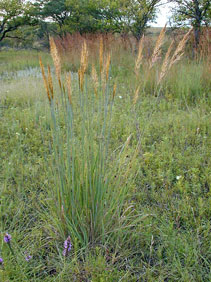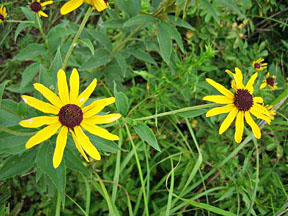
Producers
Being that it is a grassland, not many trees are found in the biome. When they do appear, it is always near sources of water.
The soil though, is very fertile. Making grasslands a perfect home for many species of plants.
These are all Producers, who take in sunlight, and create their own food (glucose, sugar) through photosynthesis. They are the bottom of all pyramids and provide the rest of the ecosystem with energy.
Plants
Big Bluestem
Andropogon gerardii
Big Bluestem is the tallest plant on the prarie! This woody stalk grows in large clumps and the roots extend just as far into the soil as they do into the sky, between 7 and 10 feet. (MRWM 1) It is a favorite and important food of livestock and wild animals. (MRWM 4) Big Bluestem prefer to be in moist soil, and was common in floodplains. That is before they were plowed down for agricultural purposes. (MRWM 4) But the Big Bluestem lives on strong.

Indian Grass
Sorghastrum nutans
Indian Grass is another important grass to the diet of livestock and other primary consumers. Just like the Big Bluestem, this grass prefers deep, moist soil but it can also be found on dry slopes. (KWG 8) Indian Grass also works in a process called mutualism with the birds and small mammals of the area. (10) This means both parties benifit from the connection between them. In this case, it is the birds and mammals having food to eat. Then when their metabolism has digested the nurtients and disposes of the left over waste, it acts as a vessel to carry the Indian Grass' seeds. This will keep the population alive.

Wild Lupine
Lupinus perennis
It is a perennial plant, that can reach about 2 feet in hight. (OPF 1) The plant fairs best in a bit of a moist soil, but can withstand being dry. (5) To produce a healthy plant, it must be planted at least 3/4 an inch under soil. (8) As is the case most plants of the prarie, it is assumed that eating it would be unhealthy, as it harbors toxins. ( 11)

Showy Milkweed
Asclepsias speciosa
The showy milkweed is found in North America. It can grow to hights of 4 feet, and its leaves may get to be over 6 inches long. The plant is generally avoided by grazing livestock because it is very bitter tasting and toxic. In the past parts have been boiled and used as medicine. (NPWCR 2) Milkweed in general attracks Monarch butterflies, because they feed off the toxin that kills other organisms, and the buterflies help pollinate the milkweed. They are therefore interdependant.

Spiderwort
Tradescantia sp.
These wildflowers bloom late spring, and grow to about the knee of an average person.(GPNC 1) The common nickname for the flowers is 'cow slobber'. In the prarie they are more located in the drier soils. (3) Their average lifespan is very short as well, about a day after blooming. (4) Though this is a bit of a disadvantage, spiderwort plants themself produce many little flowers on each stem, leaving the viewer with an endless supply of beauty. (4) The flower petals are quick to decompose, and thoughout the blooming season, they are always beautiful to watch.
Smooth Aster
Aster laevis
This flower is mainly found in dry areas of soil. They get get between 1 and 3 feet in high, and are native to North America. (CBS)

Sweet Coneflower
Rudbeckia subtomentosa
The Sweet Coneflower is the most beautiful flower seen on the prarie. It gets between 1 and 4 feet high. (NHNA 1) It is in season between August and September every year (3), and of course is a perennial. It does not need much water to survive, nor a determained amount of sunlight. They are extremly durable. (Backyard Garden 2) Unlike the other plants, the sweet coneflower is not toxic, and therefore ediable.

Did you know?
Baby Giraffes are called calfs, and they spend 15 months inside their mothers wombs before dropping to the grassland. (BBC 10)
About 50% of calfs die in their first 6 months of life in the hands of preditors. (BBC 10)
The average life-span is 25 years, and 28 in captivity. (BBC 3)

